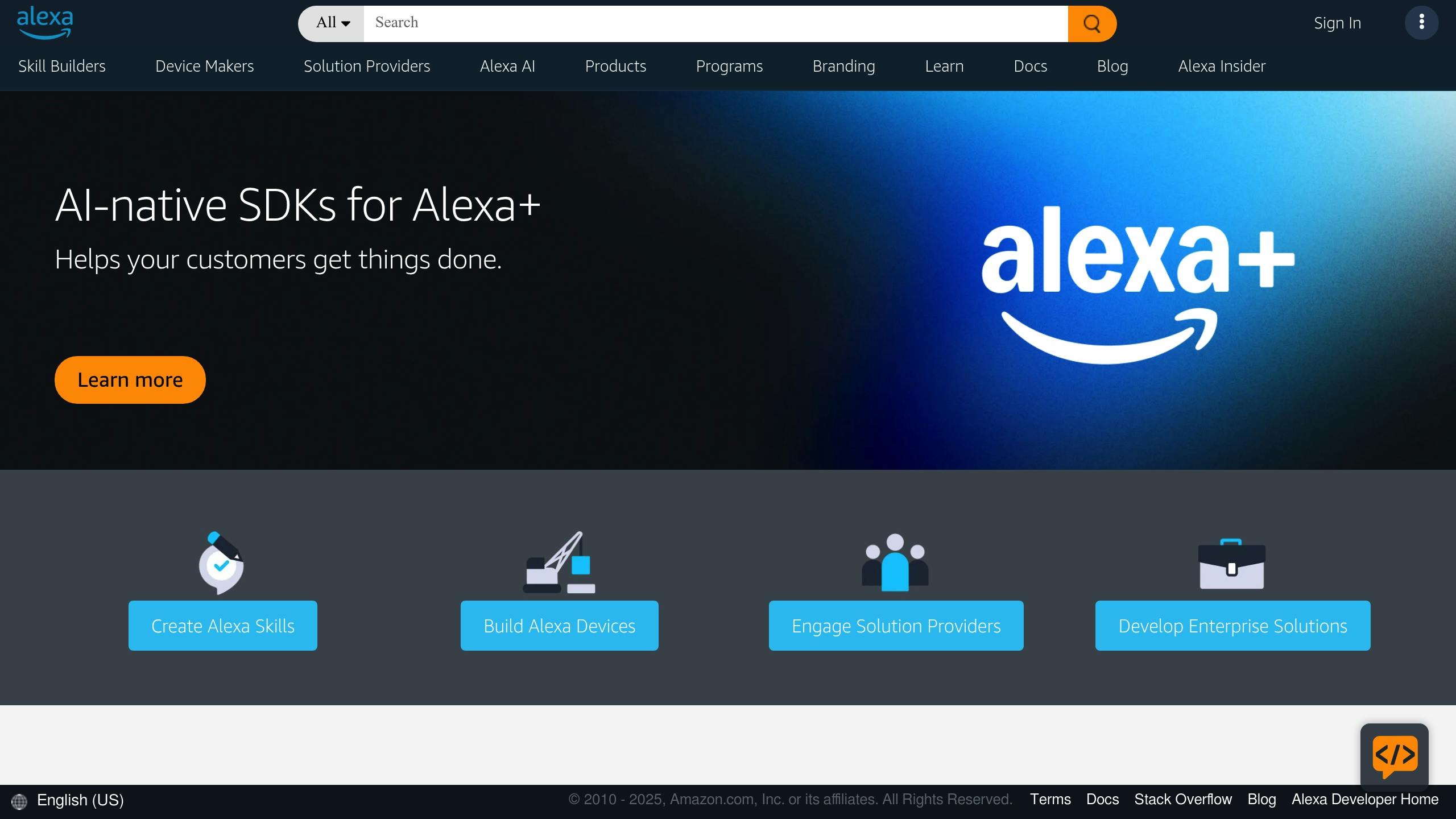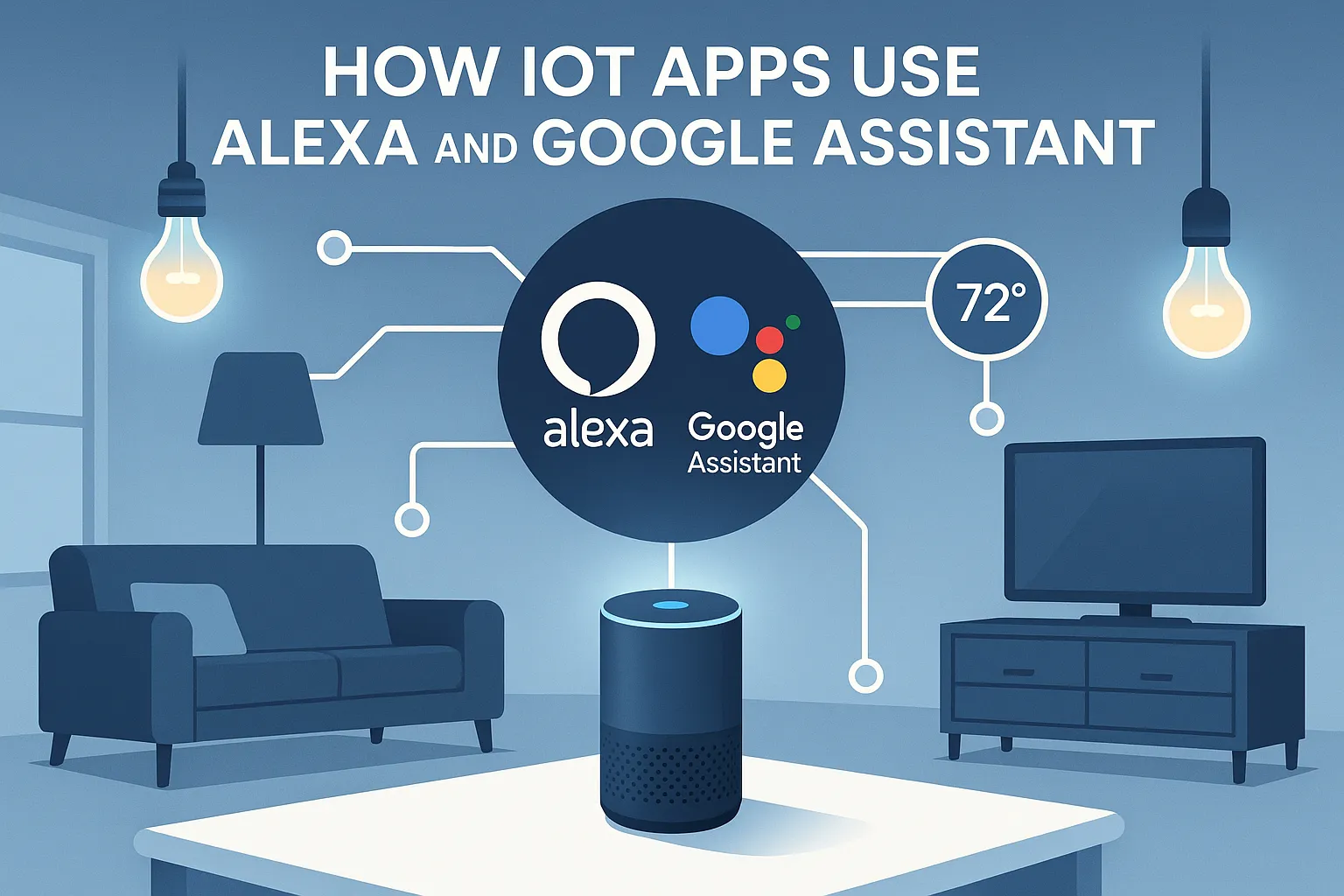Voice assistants (VCs) like Alexa and Google Assistant are transforming how we use IoT devices. They make controlling smart homes, medical devices, and business systems easier through simple voice commands. Here’s a quick breakdown:
- Smart Homes: Manage lights, thermostats, and routines with voice commands like “Alexa, turn on movie mode.”
- Healthcare: Adjust medical devices or access health info hands-free.
- Business: Enable tasks like inventory management or guest room control in hospitality.
Key Differences:
- Alexa excels with customizable routines and its Skills platform.
- Google Assistant offers smoother conversations with context retention.
As AI improves, voice-controlled IoT will become smarter, more personalized, and widely used across industries. Prioritize security, connectivity, and intuitive voice commands when building IoT solutions.
IoT Applications Using Alexa and Google Assistant

Smart Home Control
Voice-controlled IoT is transforming smart home automation. Devices like the Philips Hue lighting system let users manage lights with simple commands such as “Alexa, turn on movie mode” or “Hey Google, dim the lights.” Nest’s Learning Thermostat takes it further by enabling voice-controlled temperature adjustments, which can be part of larger home automation routines. These features make managing your home easier and more intuitive, paving the way for more tailored applications in other fields.
Medical Device Integration
In healthcare, voice assistants are becoming a key part of IoT medical devices. They allow patients and caregivers to quickly access health information, adjust device settings, or request help – all through verbal commands. This makes technology easier to use and helps improve the overall care experience.
Business Applications
Voice-controlled IoT is also making waves in commercial settings. In the hospitality industry, for example, guests can use voice commands to control room features like lighting or temperature. Beyond customer convenience, voice assistants are aiding businesses with tasks such as inventory management and real-time coordination. This technology is changing the way businesses operate and interact with customers.
Alexa vs Google Assistant for IoT
Alexa Features
It offers a Skills platform that allows users to create custom voice commands for various smart devices. It works with a wide range of devices, including those for lighting, climate control, and security systems. One standout feature is the ability to set up routines, enabling multiple actions to be triggered with a single voice command.
Google Assistant Features
Google Assistant is deeply integrated into the Google ecosystem, making it a strong option for managing smart devices. A key feature is its ability to maintain context during interactions, so you don’t have to repeat wake words. This creates a more natural and fluid conversation experience when controlling connected devices.
Feature Comparison
Alexa shines with its Skills platform and the flexibility of its routines. On the other hand, Google Assistant stands out for its contextual understanding and smooth conversational flow. The best choice depends on your specific IoT setup and how you prefer to interact with your devices. Both platforms offer unique strengths, shaping the future of voice-controlled IoT.
Alexa and Google… It’s Inevitable
sbb-itb-7432820
What’s Next for Voice-Controlled IoT
Voice control in IoT is evolving rapidly, with new trends pushing its capabilities to the next level.
AI and Language Processing Updates
AI advancements are reshaping how voice-controlled IoT systems work. Assistants are now better at understanding natural language and learning user habits, delivering more personalized and precise responses. They can also retain context, making conversations smoother and more natural. On top of that, improved coordination across multiple devices allows these systems to handle complex IoT tasks, using real-time sensor data to make smarter decisions.
Expanding Industry Applications
Voice features are making waves in industries like manufacturing, healthcare, and retail. In manufacturing, voice control offers hands-free operation, improving safety and efficiency during equipment use and maintenance. In healthcare, these systems provide access to medical records and enable automated patient monitoring. Meanwhile, in retail, voice commerce works with IoT sensors for tasks like checking inventory, suggesting products, and automating reorders.
As AI continues to advance, voice control is becoming a core feature in IoT solutions across these sectors.
Summary
Voice-controlled IoT connects smart devices with platforms like Alexa and Google Assistant, each with its own advantages. Building such systems requires strong security measures, dependable connectivity, and a focus on voice data privacy.
For businesses developing IoT solutions, it’s essential to work with skilled teams to handle system complexities, secure communication channels, authenticate devices, and create user-friendly voice commands.
Key areas to focus on when implementing voice-controlled IoT include:
- Security: Protect voice data with advanced protocols.
- Connectivity: Ensure a stable internet connection for smooth operation.
- Interface: Develop natural and intuitive voice interactions.
As AI and language processing continue to grow, IoT systems will become even more capable, offering deeper integration and broader applications across various industries. Partnering with experts who understand both IoT infrastructure and voice assistant technology ensures secure and efficient solutions, paving the way for future advancements.
FAQs
How do Alexa and Google Assistant make smart home IoT devices more efficient?
Alexa and Google Assistant enhance smart home IoT devices by enabling voice control, making it easier to manage connected devices hands-free. For example, you can use voice commands to adjust your thermostat, turn lights on or off, or even lock your doors, all without needing to interact with a smartphone or physical controls.
These virtual assistants also integrate with a wide range of IoT devices, creating a seamless smart home ecosystem. By connecting multiple devices, such as security cameras, smart appliances, and entertainment systems, they allow users to automate routines, like setting a morning schedule where the coffee maker starts brewing, lights turn on, and the thermostat adjusts to your preferred temperature – all triggered by a single command.
What security measures should you consider when integrating Alexa or Google Assistant with IoT devices?
When integrating voice assistants like Alexa or Google Assistant with IoT systems, it’s crucial to prioritize security to protect user data and ensure system integrity. Here are some key considerations:
- Data Encryption: Always encrypt data during transmission to prevent unauthorized access.
- Authentication and Authorization: Implement strong authentication protocols to verify users and restrict access to sensitive functions.
- Firmware and Software Updates: Regularly update IoT devices and voice assistant integrations to patch vulnerabilities.
- Network Security: Use secure Wi-Fi networks and firewalls to safeguard communication between devices.
By addressing these areas, you can enhance the security of your IoT systems while offering a seamless voice control experience for users.
How do Alexa and Google Assistant enhance IoT applications in industries like healthcare and retail?
VCs like Alexa and Google Assistant significantly enhance IoT applications by enabling seamless voice control and interaction. Their advanced AI and natural language processing (NLP) capabilities allow users to perform tasks hands-free, making them particularly valuable in industries like healthcare and retail. For example, in healthcare, voice assistants can help patients schedule appointments or access medical information, while in retail, they enable personalized shopping experiences and streamlined inventory management.
By integrating these voice assistants, IoT applications become more intuitive and accessible, improving efficiency and user satisfaction across various industries.




